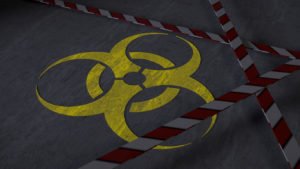A suspected gas attack in Syria early yesterday morning killed at least 70 people and injured close to 500.
 It is unclear which chemical was used in the attack or whether it is the same chemical, Sarin, that was used in the last major gas attack in Syria in 2013.
It is unclear which chemical was used in the attack or whether it is the same chemical, Sarin, that was used in the last major gas attack in Syria in 2013.
The Australian Science Media Centre gathered expert comment on the attack. Please feel free to use these comments in your reporting.
Associate Professor David Caldicott, Emergency Consultant and Senior Clinical Lecturer in Medicine, Australian National University, comments:
“It is still too early to establish what agents were used in the mass casualty exposure in Syria in the last 24 hours. Footage has been limited, albeit distressing, showing patients of all age groups in apparent respiratory distress. This footage is certainly consistent with exposure to a chemical agent. However, there are many agents, both military and industrial, that are capable of causing such symptoms.
“What we know for certain is that Syria has form in using chemical weapons against political opponents, and that historically, much of that weaponry has been linked to Russia. It is telling that Russian officials did not open with a statement denying that chemical agents had been deployed, but rather that they were the source.
“The two most likely agents in terms of availability are the ubiquitous industrial gas chlorine, and the specifically militarised nerve agent, sarin. Chlorine is a choking agent, causing the lungs to rapidly fill with fluid and asphyxiate the patient. Sarin belongs to a family of poisons called the organophosphates. It blocks the action of a critical enzyme in the human nerve synapse, called acetylcholinesterase.
“This enzyme normally turns off the nerve signal when it’s finished, so if its action is blocked, the signal stays on- for every neuron in the body that uses acetylcholine as a neurotransmitter. And there’s a lot that do. Death is rapid, and usually as a consequence of the muscles of breathing no longer being able to function, coupled to increased lung secretions, and narrowing of the airways.
“Sarin is stunningly potent, requiring tiny doses to be fatal. There are antidotes, such as atropine and pralidoxime, but these would be very unlikely to be available in the quantities needed for that number of patients, in that environment. In the Ghouta attacks of 2013, first responders could only intubate patients to keep their airways open- those who could mount a respiratory effort survived- those who couldn’t, didn’t.
“Emergency response to chemical incidents such as this are very complicated as the patients themselves, if not decontaminated, can poison those attempting to assist them. Footage seen to date does not show any responders using the personal protective equipment (PPE) that would be deployed in first world circumstances. It is not possible to say whether that was due to lack of availability, or the fact that patients had already been decontaminated elsewhere.
“Much of the effort now will be in establishing the nature of agent involved, and it’s origins. The former is not difficult, the latter, much more so. Forensic material is currently being gathered and will be made available to the OPCW (Organisation for the Prohibition of Chemical Weapons) and their agents. That might be clothing or blood samples. There are tests that can measure levels of sarin itself, it’s breakdown products, or reduced levels of the enzyme it effects in the blood. ‘Fluoride regeneration’ can identify exposure up to 2 months after the event.
“Obfuscation will be the name of the game with regards to perpetrators. The bombing of the hospital to which victims were taken- itself a war crime- may have been an attempt to bury any evidence. And the presence of Russian warplanes on the ground makes military options against the Syrians all the more hazardous. The only certainty from these horrendous events is that thousands of innocent Syrian civilians, already eviscerated by a seemingly unendable civil war, today have a little less security, and a little more pain, than they did the day before.”
Dino L. Pisaniello, Professor at the School of Public Health, University of Adelaide, comments:
“Until the identity of the chemical is known, the best guess is a nerve agent (an anticholinesterase compound), probably an organophosphate. The characteristic response of pin point pupils is a key clinical observation here.
“Sarin is suspected but there are many organophosphate insecticides that would exert the same effect (in sufficient quantity). Interestingly the early nerve agent chemical weapons were developed from research on effective insecticides in the 1950s. It is possible that an organophosphate pesticide or a simple organophosphate (not classified as a chemical weapon) was used.
“Survivors of the Tokyo subway sarin attack recovered reasonably well but with some clinically detectable neurological effects and there is evidence of brain changes.”
Paul Walker, International Director of Environmental Security and Sustainability, Green Cross International, comments:
“Chemical weapons and toxic industrial chemicals used in the Syrian civil war have killed and injured thousands of innocent civilians. With another deadly chemical weapon attack taking place in Syria this week, weapons of mass destruction clearly pose a threat to humankind, the environment, and public health.
“Any use of chemicals as a weapon of mass destruction is a war crime and has been banned by 98 per cent of the world’s population.
“Whoever has attacked Syria is a war criminal and needs to be prosecuted under the criminal court. You can’t have a healthy community, region, country or world unless we stop committing such violence. When you have violence of this massive and inhumane nature, it is an absolute threat to public health.
“We are abolishing the whole field of weapons of mass destruction. It’s taken 25 years or more but we’re almost there.”